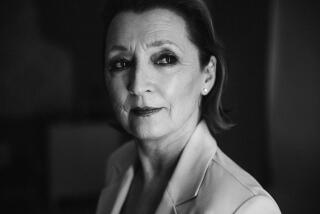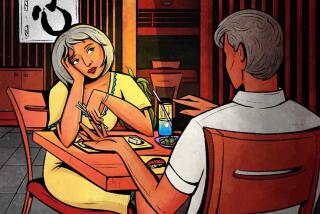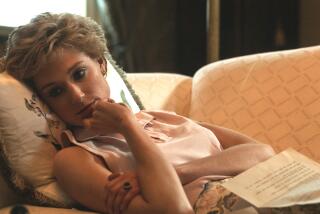A Fractured Fairy Tale at the Palace : Books: A royal watcher takes a new look at the dark side of the British first family. The author admits it’s a one-sided view of Princess Diana.
- Share via
NEW YORK — It was the first big blowout of the rapacious 1980s. Not only was the marriage of the dashing Prince to the blushing Lady celebrated throughout the kingdom, 740 million people also watched on the telly.
But with the 1980s repudiated, we’re also now learning details about happily-ever-after that we probably could do without.
Truth’s newest version has Princess Diana, the virgin bride, becoming a miserable matron. Trapped in a loveless marriage, she numbs her pain by throwing herself into charity work when she’s not throwing up.
In “Diana, Her True Story,” author Andrew Morton offers up these latest sad if not vulgar details about the royal couple’s life, replete with 80 color photographs and numerous passages comparing the princess to everybody from Cinderella to Othello.
All the juiciest stuff--the princess’ attempts to off herself, her bulimia and her rage over Charles’ ongoing friendship (wink, wink) with an old girlfriend--allegedly come direct from her family and close friends, including a former flat mate, Carolyn Bartholomew. Diana’s recent visit to Bartholomew’s home and their kissy-face goodby in front of a legion of photographers was, for many royal watchers, authentication enough that Morton got it right. The only thing better would have been if she had come along on the author’s U. S. book tour, during which Morton, 38, is promoting “Her True Story” like crazy.
But drawing conclusions from the princess’ public appearance has already gotten the unsuspecting public in a lot of trouble. We probably bought hook, line and sinker that Diana was a giddy bride-to-be before the Big Wedding back in the summer of 1981. Morton tells it differently: She was a neurotic mess whose sisters had to persuade to walk down the aisle after she discovered an engraved bracelet her prince was giving to his old flame.
So much for reality.
Yet even from this distance, from where commoners in the Colonies observe, Diana has been a model princess: She shows up at things on time, she behaves, she’s beautiful, she’s beloved, and though she’s no rocket scientist, she’s got enough circuits working to have embraced the right issues, such as AIDS and homelessness.
We can also tell she’s married to a guy probably more interesting than people give him credit for, but who is, essentially, a stiff. Morton writes that a onetime aide to Charles said the prince probably would have been happier remaining a bachelor: “If he had his fishing tackle ready, his polo ponies saddled and a 5 note for the church collection, he was perfectly happy.”
Morton is the first to admit his book simply puts “flesh and bones on all the ugly gossip” that has been dribbling out for the last couple of years. He also acknowledges it is a one-sided view.
“I make no excuses at all,” Morton says. “It’s from Diana’s perspective--not just of their marriage, which is the most contentious point, but of her childhood, the way she used to listen to her little brother Charles cry himself to sleep after their parents’ divorce and the way she felt she should have been born a boy.
“It’s how she saw her life . . . how she saw her awful introduction to the royal family. And that’s her truth, which is no more or less important than the objective truth. . . .
“You read any biography of the prince in which his friends extol his virtues, and it’s always a portrait of a very caring, dynamic individual with a rather dim, lightweight wife who thinks that Afghanistan is a type of cheese. Well, her friends have a different view.”
Morton claims Diana’s friends began talking to him after they were disgusted with a series of books and articles to mark the prince and princess’ 10th anniversary last summer and her 30th birthday. Diana, typically, was portrayed as a dumb blond in a ball gown and Charles, a dutiful prince; their marriage was seen as amicable though distant.
In Morton’s book, Charles is a cold, selfish, spoiled man who went to the opera after his son suffered a fractured skull instead of waiting with his wife while the boy underwent brain surgery.
But, in this book, nobody comes off terribly well.
In the end, even Diana seems quite the self-obsessed, jealous, volatile child, who is easily defeated and considerably lacking intellectually.
It’s hard not to wonder what the princess hoped to accomplish by revealing--if she did--the fractured fairy tale that is her pathetic life. What was her ultimate goal in not stopping these stories if not to get back at Charles and get his attention--if not his goat?
Morton gives evidence Diana is of two minds. On one hand, he quotes her therapist (yes, even her shrink goes on the record) and astrologer saying she could bolt at any moment. “Diana is no longer willing to put up with a life of deceit,” her therapist, Stephen Twigg, opined to Morton. Yet Morton also suggests that what Diana really wants is respect from Charles and the whole royal cabal, and a more separate but equal life.
The separation after five years between the Duke and Duchess of York--Fergie to her public--apparently also was a turning point. Morton claims that Fergie put a lot of pressure on Diana to jump ship with her: “If I actually published my notes of all this you’d see that: ‘Diana’s in tears today’; ‘Diana’s feeling very depressed today’; ‘Fergie’s been on the phone; Fergie’s been saying let’s jump together, let’s go. . . . Diana is resisting.’ ”
Morton blames the queen and her consorts for the misery the two experienced as newcomers to the royal troupe, saying if they had some kind of training or mission statement they might have made it: “Their introduction to the family was all done in a very haphazard way, and now the family is paying the price for it.”
Yet there is some good news.
Instead of vomiting four times a day, the princess now has it down to once every three weeks; though she suffered a cold, lonely childhood, she gives princes William and Harry--known as the Heir and the Spare--lots of cuddles, and after years of whimpering, agonizing and throwing tantrums, she has found herself through a sort of New Age martyrdom.
While Diana likes her crystals, Tarot cards and astrology readings, she gets more out of work with the homeless, people with AIDS and others facing death. This portrait as a saint is slightly unnerving.
While visiting her husband at a hospital, where he was being treated for a broken arm, she peers into the intensive care unit and sees a family surrounding a dying woman. She asks the family if she can join them and for the next two hours holds the dying woman’s hands. When the grieving children come in, they don’t recognize the woman at their mother’s bedside and she says, “Just call me Diana.” She later sends a two-page letter of sympathy.
“It was a watershed event for a woman who for so long had thought herself worthless, with little to offer the world other than her sense of style,” writes Morton.
But her self-discovery aside, it’s hard to determine whether we should chuck our Charles and Di wedding souvenirs.
Probably not quite yet.
Morton argues that Diana wants to reform the monarchy, to make it more relevant. So she’ll probably stick around to make sure her sons are raised right. And Morton, who grew up in Yorkshire among Britain’s middle class that has long looked to the monarchy for stability, says he, too, will stick around:
“I think this is the most fascinating period of royal history since the abdication.”
More to Read
Sign up for our Book Club newsletter
Get the latest news, events and more from the Los Angeles Times Book Club, and help us get L.A. reading and talking.
You may occasionally receive promotional content from the Los Angeles Times.










